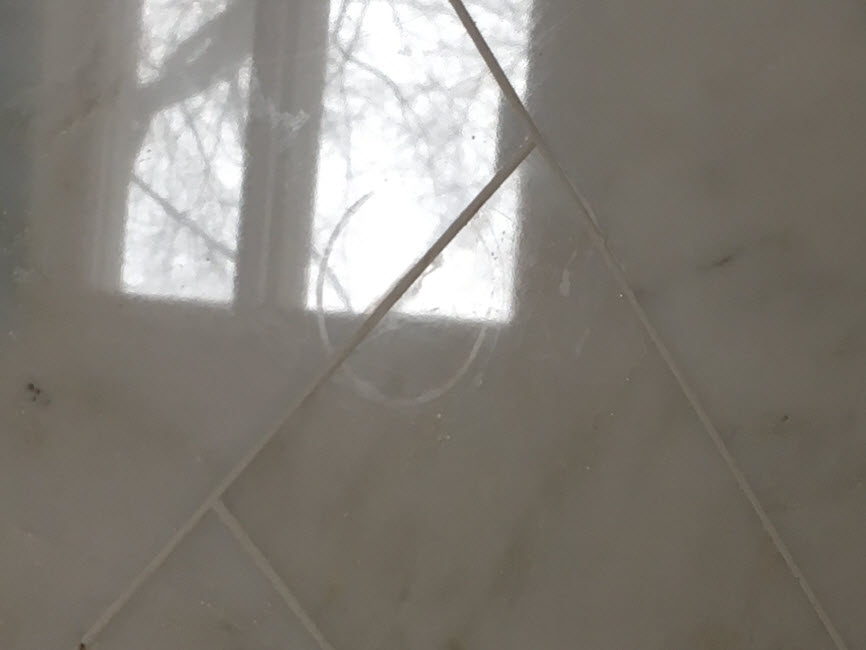
Wondering how to best protect your marble tile? Consider a sealer and more specifically a penetrating sealer to keep your stone flooring looking beautiful.
To illustrate why here's a tile installation situation Mark Heinlein CTI #1112 and National Tile Contractors Association Training Director and Technical Trainer / Presenter recently addressed with the help of Scott Carothers.
An Insidious Circular Mark on a Newly Installed Stone Floor
Mark received the photo above which seemingly shows a ring mark on Hampton Carrara Polished marble tile.
According to the contractor, removing the lippage control clips took off the polish which seemed to be peeling off. He had to sand the floor down and buff it for the customer. These weren't new spacers and the contractor had never encountered this specific situation.
What could have caused it?
First Analysis: A Topical Sealer Didn't Cure Adequately?
Mark's first review and analysis of the image above suggested the following:
"It appears that a topical sealer rather than a penetrating sealer may have been applied and it adhered to the bottom of the cap of the lippage tuning device and the sealer came up with the cap when it was removed.
If that was the case, perhaps the sealer was not allowed to cure adequately before the lippage tuning devices were installed?"
However, he soon learned that the installer had applied no topical (or penetrating) sealer to the marble.
Next Analysis: Was an Acidic Liquid Spilled onto the Marble Surface?
Given the additional information about the sealer, Mark and Scott provided the following analysis and related questions:
Lippage Tuning Devices Shouldn't Affect Stone
A lippage tuning device of this type that does not slide or spin across the surface of the stone should have no adverse effect on either a polished or honed stone.
- Have you been able to measure the diameter of the etching and compare it to the diameter of the lippage tuning device cap?
- The location of the etching is not necessarily standard placement for a lippage tuning device. Was there evidence of this in more than one location?
This Looks Like the Result of an Acidic Spill
Next, they questioned whether something had spilled onto the tile.
Since this is a polished stone with no sealer applied, it could be a case of a container of some sort of acidic liquid (cleaning material? a carbonated acidic beverage?) that had been placed on the stone with some of the liquid spilled down the sides of the container, onto the stone etching the surface.
From the photo, both Mark and Scott noticed that there were also some spills or drips near the circular etching.
How to Protect from Unexpected Acidic Spills? Try a Penetrating Sealer
Ultimately, when you are working with a porous tile product - such as marble or other natural stone tiles - using a sealer may be advisable.
What is a sealer?
A sealer helps minimize stains and makes the surface easier to clean. Some of these products also help to enhance the look and color of the stone.
You'll find two types of sealers: a topical sealer and a penetrating sealer.
- Topical sealers reside on the surface of the tile and tend to require routine maintenance and resealing as it wears off. They block stains and provide either a matte, semi-gloss, or gloss finish.
- Penetrating sealers enter into the pores of the stone which normally will not change the appearance of the stone and tend to require less routine maintenance.
According to the 2018-2019 NTCA Reference Manual,
“Regardless of the sealer used, it is always important to make sure the tile, stone, and grout surfaces are clean and dry before sealer application. It is also critical to follow product directions completely. Do a test to insure desired results and call the sealer manufacturer’s technical hotline if not sure of choices or options. Important sealer qualities or characteristics to consider include level of stain resistance; moisture vapor transmission (especially in exterior areas); UV resistance; freeze-thaw stability; slip resistance; chemical resistance; ease of re-application; longevity and finished look provided.”
Additionally, the Reference Manual states,
“While most surfaces and installations will benefit from the use of a sealer, it is up to the enduser or purchaser to determine the need, suitability, and overall value of sealing.”
Had the marble tile described above been treated with a penetrating sealer, the possibility of this circular mark may have been reduced or prevented.
Want to Learn More About Sealers?
You'll find several informative archived webinars available on the NTCA website about sealers. They describe what sealers are, how they work, and how to select them, apply them and maintain them.
If you haven't already, consider becoming a Certified Tile Installer so you learn to ask the right questions and anticipate tile installation issues before they occur.
Thanks for reading.
Note: We originally published this article on 09/04/2018, and have updated it.

